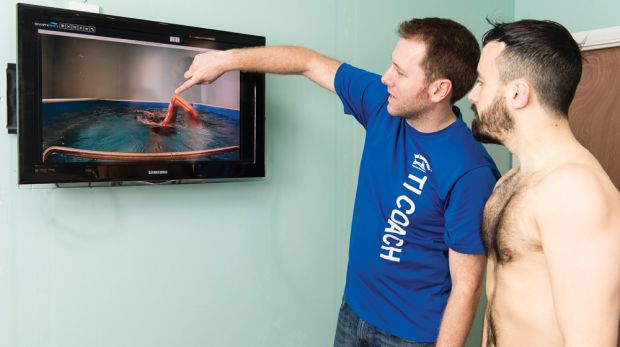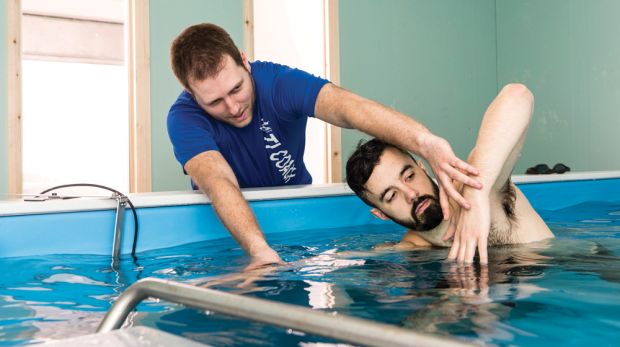
In This Series
- Introduction
- UK Triathlons 2019
- How To Train For A Triathlon
- Triathlon Training Plans for Sprint, Olympic and Half Iron Distances
- 9 Ways to Boost Your Triathlon Endurance
- Total Immersion Swimming for Triathletes
- Triathlon Gear Buyer’s Guide
- Triathlon Kit
What is Total Immersion?
Swimming, but not as you know it. Originally developed in the 1970s, and long considered endurance sports’ best-kept secret, Total Immersion (TI) is making an impact today with a new generation of triathletes adopting the technique. TI flips the traditional approach to teaching front crawl on its head, providing serious speed and efficiency gains in short timeframes by encouraging swimmers to work with the water, rather than against it.
“Most people learn to swim when they’re at school – where the emphasis is on not drowning rather than developing an efficient stroke – and carry the bad habits they pick up into adult life,” says TI coach Sam Williams of Swim Studio London. “This generally leads to a wild, thrashing style born of survival instinct, all windmilling arms and aggressive leg kicking. As a result, only 4% of adult swimmers can manage 400m or further continuously, because their stroke isn’t sustainable.”
This is my problem in a nutshell. I can doggy-paddle all day, and I’ve even managed to bob my way through a couple of sprint-distance triathlons using a granny-like variety of breast stroke, but when it comes to front crawl my technique is so poor that doing a few lengths at the local pool leaves me utterly gassed, watching ruefully from the shallow end as old ladies and armband-clad children cruise effortlessly past me.
Could TI really redress a lifetime of terrible freestyle form in a few weeks?
The Method
“Traditional swimming is based around power,” says Williams. “You’re kicking and pulling your way through the water, using roughly 80% of your energy expenditure and oxygen consumption just to stay afloat and counteract the fact that you’re not very streamlined and extremely unbalanced. TI, on the other hand, is an exercise in control. Your body is naturally unstable in the water, so we slow everything down to find the point where you’re balanced. For example, people tend to look forward rather than down when they’re swimming, which causes their legs to sink.”
Once a TI coach has identified and corrected these kinds of postural issues and you’re comfortable in a balanced position, they can teach you new movement patterns. “These help keep you streamlined – such as spearing your left hand forward as you kick your right foot – and develop an efficient stroke,” Williams explains. “Once you’ve got this established as a base, you can then apply power purely for the purpose of propelling yourself forward faster.”
The benefits extend beyond performance, too. “Traditional front crawl leaves you far more susceptible to injury, as you’ll often end up internally rotating your shoulder joint, and straining your neck and back,” says Williams. “TI develops a relaxed stroke that helps to extend the spine and improve joint mobility, making it an ideal, full-body, low-impact aerobic activity that’s sustainable into later life.”
Sign up for workout ideas, training advice, reviews of the latest gear and more.
The Test

Less than five minutes into my first session, Williams diagnosed a multitude of issues that have been holding me back, including an over-aggressive kick, a lack of inter-limb co-ordination and a jerky, panicked breathing style. The first thing I needed to do was learn to relax in the water, which involved pushing off very gently from the side of the pool and simply floating forward, with my arms extended and face down. It felt odd – and more than a little ridiculous – for the first few sessions, but I rapidly became far more aware of my body position in the water, and was able to adjust accordingly so that my legs rose to the surface rather than sinking immediately as before.
Over the weeks that followed, Williams began rebuilding my stroke one element at a time. Once I was comfortable maintaining a balanced floating position, he showed me how to replace my previously wild kicking style with a gentle, controlled flutter that I could actually sustain for minutes at a time without exhausting my legs. This reduced range of motion also ensured that my overall body position remained far more streamlined in the water.
The next step was to generate efficient power. Previously I’d been trying to pull myself through the water, which required constant, energy-sapping tension in my hands and arms. Williams instead taught me to propel myself forward by rotating my torso and hips in unison, using a piston-like motion with my arms and hands relaxed throughout. And although it took weeks of practice to reach a point where I could sustain it, the difference during the short bursts when it did click was immediate and marked.

The Verdict
After just over four weeks of TI, my max distance front crawl jumped from an utterly exhausting 50m to a manageable (if far from pretty) 400m – an 800% increase. What’s more, the logical, progressive nature of the methodology meant that even if I couldn’t maintain every element of my newly developed stroke simultaneously – usually due to a lack of concentration – I was always aware of what had started to slip and when, ensuring that I was able to focus on and attempt to correct it on the next length.
And although it did require a reasonable time commitment of two to three 20-minute sessions a week on top of my weekly hour-long lessons with Williams, the relaxed stroke style and low-impact nature of swimming in general meant that it didn’t negatively impact or compromise my regular gym workouts or my performance on the five-a-side pitch. If anything, hitting the pool after a tough weights session actually worked as an excellent mobility-based warm-down.
And at the end of the day, picking up a legit life skill that will still be physically viable when my joints become too knackered for anything else is more than worth a month of dedicated training. Next stop: using it to smash my doggy-paddle triathlon PB.
RECOMMENDED: Half Iron Triathlon 12-Week Training Plan
Between 2010 and 2016, Ben was the deputy editor of Men’s Fitness UK, which predated, and then shared a website with, Coach. Ben also contributed exclusive features to Coach on topics such as football drills, triathlon training plans and healthy eating.

